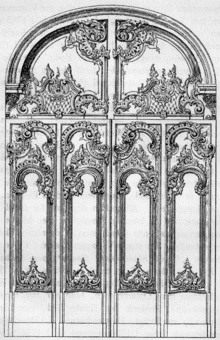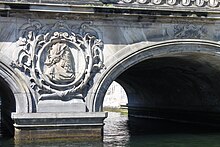Louis August le Clerc

Louis August le Clerc , also Louis-Augustin le Clerc (* 1688 in Metz ; † March 8, 1771 in Copenhagen ) was a French sculptor who worked in Denmark from the age of 47 until his death as a court sculptor and professor at the Royal Danish Academy of Art worked. He contributed to the introduction of Rococo in Denmark.
Life
Louis August le Clerc was the son of the engraver Sébastien Le Clerc and his wife Charlotte van den Kerckhove. He studied at the Académie royale de peinture et de sculpture with the sculptor Charles-Antoine Coysevox . During his studies, two of his works were awarded by the academy.
From 1734–1735 he traveled to Ansbach in Bavaria and to Brühl near Cologne. In Ansbach he worked for Margrave Karl Wilhelm Friedrich of Brandenburg-Ansbach. In Brühl he worked 1734-1735 for the Cologne Archbishop and Elector Clemens August von Wittelsbach as assistant to the Bavarian court architect François de Cuvilliés at the electoral hunting seat Falkenlust. The neighboring castles of Augustusburg and Falkenlust are now considered to be important late Baroque and Rococo buildings in the Rhineland ; they were declared a World Heritage Site by UNESCO in 1984 . To this day, groups of figures in the wall niches of the upper vestibule , made by le Clerc, have been preserved at Falkenlust Castle .
Appointment to Denmark
In the summer of 1735 le Clerc was by King Christian VI. Appointed from Denmark to Copenhagen to help with the interior design of the new Christiansborg palace . Together with his wife Caroline Wilhelmine Isabella he moved to Denmark and was appointed court sculptor in December of the same year.
Together with the architects Elias David Häusser and Nicolai Eigtved , he is one of the key planners and builders of Christiansborg and was primarily responsible for the sculptures and stone carvings in 1737. Almost all of his work in Christiansborg, however, was destroyed in the palace fire in 1794.
The wood-carved vases in the stables of Christiansborg and the relief medallions on the side of the marble bridge ( marble office ) that leads to the main entrance of the castle have been preserved to this day . Four perspective drawings by Christiansborg by Le Clercs (174 / -1747) are preserved in the Kupferstichkabinett in Copenhagen.
In 1739 he created a fountain for the Royal Gardens ( Kongens Have ) of Rosenborg Castle with a boy and a swan. The original made of sandstone was replaced in 1837 by a bronze sculpture with a similar motif by the sculptor Hermann Ernst Freund .
The knight's hall in the Moltke Palace of Amalienborg Palace also contains his carvings.
Guided tour of the Royal Art Academy
After Hinrich Krock's death in 1738, le Clerc and the Venetian history painter Hieronimo Miani took over the management of the young Danish Academy, which at that time was still called the Academy of Drawing and Painting ( Tegne- og Malerakademiet ). Le Clerc acted as director of this academy from 1740 to 1748, initially alone after Miani left Denmark in 1745, then the architect Nicolai Eigtved took over the leadership in the course of the change of the throne in Denmark . The year 1746 with King Friedrich V as successor to King Christian VI. meant a turning point in the art life of the absolutely governed Denmark.
Friedrich V supported the academy, but his taste in art was different. Le Clerc received the title of professor at the academy, but the art he represented was increasingly in less demand.
In 1754 Friedrich V founded the art academy that exists today ( Det kongelige skildre-, billedhugger- og bygningsakademi ). As a professor, Le Clerc became a member of this academy in the year it was founded; however, it no longer played a role in the Danish art world. This became clear through the appointment of the French sculptor Jacques Saly to Denmark in 1752; he was commissioned to create the monumental equestrian statue of Frederick. V. for the courtyard of Amalienborg. Le Clerc had become meaningless.
He continued to work as a professor at the academy until his death. This keeps his portrait painted by Carl Gustaf Pilo . He died in his house on Brolæggerstræde in Copenhagen and was buried in the cemetery of the Reformed Congregation of Copenhagen.
family
After the death of his first wife in January 1741, he married Jacobine Louise Lefèvre in January 1742.
literature
- Leo Swane : Le Clerc, Louis Auguste . In: Hans Vollmer (Hrsg.): General lexicon of fine artists from antiquity to the present . Founded by Ulrich Thieme and Felix Becker . tape 22 : Krügner – Leitch . EA Seemann, Leipzig 1928, p. 523 .
- KID Art Index Danmark (“Art Index Denmark”)
- FJ Meier: le Clerc, Louis Auguste . In: Carl Frederik Bricka (Ed.): Dansk biografisk Lexikon. Tillige omfattende Norge for Tidsrummet 1537-1814. 1st edition. tape 14 : Resen – Saxtrup . Gyldendalske Boghandels Forlag, Copenhagen 1900, p. 14 (Danish, runeberg.org ).
| personal data | |
|---|---|
| SURNAME | Le Clerc, Louis August |
| ALTERNATIVE NAMES | Le Clerc, Louis-Augustin (full name) |
| BRIEF DESCRIPTION | French sculptor |
| DATE OF BIRTH | 1688 |
| PLACE OF BIRTH | Metz |
| DATE OF DEATH | March 8, 1771 |
| Place of death | Copenhagen |


